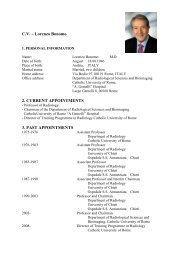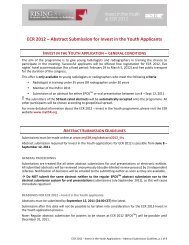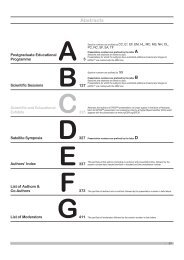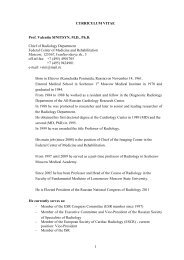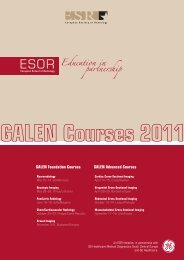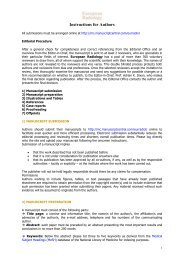Postgraduate Educational Programme - myESR.org
Postgraduate Educational Programme - myESR.org
Postgraduate Educational Programme - myESR.org
- No tags were found...
Create successful ePaper yourself
Turn your PDF publications into a flip-book with our unique Google optimized e-Paper software.
<strong>Postgraduate</strong> <strong>Educational</strong> <strong>Programme</strong>A-101 08:33How to optimise the visibility of the radiology departmentJ.A. Reekers; Amsterdam/NL (jimreekers@xs4all.nl)For decades, the radiology department was located in the basement of a hospital.Radiation was the main reason for this stuffy and airless environment. A cliniciandid not go to a radiology department, the pictures were sent to him, sometimes witha note describing what could be seen on the pictures. Imaging was easy and mostmedical specialists could read the film related to their own specialty. This has nowchanged dramatically, reading diagnostic images has become very complicated withthe new imaging modalities and consultation on which imaging technique fits bestwith a clinical question is now the domain of the radiologist. With this new positionalso a new department has to be structured as a service-centre. First of all, out ofthe basement and centrally located in the hospital. All medical conferences whereimaging plays an important role should take place at the radiology department. Thismeans that smaller and larger conference rooms with state-of-the-art projection andaccess to a PACS should be build. As all reading is done from a computer screen,workspaces should be able to facilitate interactive medical specialist discussions.Radiology departments should be <strong>org</strong>anised around medical subspecialties withfixed stations to make it easy for specialist to find there diagnostic partner. Naturallight is important but if this is not possible daylight systems will improve the wellbeing and ambiance at a department. In this session some important details willbe discussed about how to increase the radiologist’s visibility by building an opendepartment.Learning Objectives:1. To learn how to <strong>org</strong>anise a radiology department within a hospital.2. To learn how to optimise contact with clinical partners.3. To learn how to create an open radiology department.A-102 08:45Start early with radiological visibilityM. Maas; Amsterdam/NL (m.maas@amc.nl)The future of radiology depends on what current medical students think of radiologyand how they are attracted into the field. There is a high responsibility for academicradiologists to increase awareness amongst medical students considering thepivotal role of radiology as clinical speciality and of the opportunities in the field ofradiological research. Radiology has got very powerful selling points: Radiologyhas got images (one image is more than 1000 words), Radiologists are used toperform (in clinical meetings), Radiology is the most Computer Integrated Specialty,Students nowadays are computer centered learners (digital natives, HomoZappiens). Possible strategies to reach the goals are: 1. Teaching (RadiologicalAnatomy, in combination with department of Anatomy, Computer-based learningprograms, Moderating small group learning); 2. Faculty development (Clinicalrotations, Mentoring medical students); 3. Curriculum development (Board Medicalschool, National Advisory Boards). Some steps need to be taken, to be successfulin this track. Head of the Department strategically needs to reserve time and moneyfor some staff to pursue this goal. The individual Radiologist needs training in thefield of education, attends courses on curriculum building and faculty development,as well as on preparation of exams and on class room performing. CME credits inthe field of Medical Education need to be obtained. Furthermore, the person needsto be willing, creative and flexible, while skills in mentoring and providing feedbackon students also are important to develop. IT IS GREAT FUN!Learning Objectives:1. To learn how to set up an undergraduate teaching programme for radiology.2. To learn how to overcome the barriers of a traditional curriculum.3. To learn about the results of an undergraduate teaching programme for radiology.A-103 09:05Clinical radiology puts you in the spotlight: taking over the clinicalresponsibilityE. de Kerviler; Paris/FR (eric.de‐kerviler@sls.aphp.fr)Clinical radiology is the use of imaging to diagnose, treat and monitor variousdisease processes. Radiology is somewhat different from most other clinicalpractices because there is in theory a relatively weak connection to the individualpatient. However, there are subspecialties of Radiology, which include a lot ofpatient interaction. Unfortunately, the volume and complexity of imaging work hasdriven many radiologists underground. There are many other factors that influencea radiologist’s clinical implication such as administrative, managerial, teachingor research duties. The radiologist must however recover his place in patients’management, from imaging workup to therapeutic decision. This begins in guidingphysicians in the appropriate use of diagnostic imaging studies. The radiologist’sparticipation in clinical meetings is also mandatory, but this takes time and necessitatesspeaking the same language as clinicians, reading the same journals. Asan example, clinicians rely more than ever on imaging studies to assess tumourresponse to various treatments. This hidden and time-consuming work is oftennot well recognised and rewarded. Lastly, answering clinicians’ questions needsadequate reporting, avoiding dis<strong>org</strong>anized and imprecise document that can rarelybe taken seriously by colleagues.Learning Objectives:1. To learn how to become more clinically involved.2. To learn about the requirements of clinical radiology.3. To learn how to manage the clinical problems of others.A-104 09:25Radiology in the 2 1 st century: time to come out of the dark?A. Adam; London/UK (andy.adam@kcl.ac.uk)In a few years, we are likely to see 3D images generated instantly, and with comparableresolution to today’s 2D views. The detail on these images will make themincreasingly relevant as detailed diagnostic and presurgical planning tools. Inclusionof functional information, possibly at the molecular level, could also assist in clinicaldecision-making. Specialist surgeons and physicians with intimate knowledge oftheir field of interest are likely to have a better understanding of the anatomy andphysiology of an <strong>org</strong>an system than a general radiologist. So given that the imageswill be presented in a more familiar format, why should clinicians and surgeons waitfor a general radiologist to read them? If radiologists wish to retain their role as theexperts in image interpretation, they will not only need a thorough understanding ofimaging, but also a detailed understanding of anatomy and pathophysiology andthey will need to subspecialize. In addition to subspecialization, radiologists willneed to play an important role in the determination of patient pathways. The wayradiology is used at present is inefficient, as it is driven by requests for investigationsby physicians who are not equipped to use imaging efficiently. Radiologists shouldbe proactive, and should communicate with referring physicians and with patientswhen significant abnormalities are detected, planning further investigations ratherthan simply responding to requests. This will help to arrive at a diagnosis at anearlier stage, will save money and will improve clinical outcomes.Learning Objectives:1. To learn about the role of the radiologist as quality controller.2. To learn how to become proactive and drive patient pathways rather thansimply responding to requests.3. To learn about improved visibility through improved service.Panel discussion:Should we improve the visibility of the radiologist? And if yes, how? 09:4508:30 - 10:00 Room QSpecial Focus SessionSF 4bJustifying CT in paediatric radiologyA-105 08:30Chairman’s introductionC. Owens; London/UK (owensc@gosh.nhs.uk)This session will provide a vitally important opportunity to listen to experts discussingthe core issues which we face in a world with increasing expectationsand demands on the imaging world. That is to provide the best quality images inthe most challenging group of patients, i.e. children. The sensitivity of <strong>org</strong>ans toradiation and the expectations of longer survival with state of the art treatment (fordiseases which were previously lethal) dictates that we must act with prudencewhen choosing the best and most apropriate imaging modality to answer therelevant diagnostic question. The attendee will have an opportinity to indulge inthe opinions and expertise of the speakers from various relevant subspecialites.Session Objectives:1. To become familiar with the importance of CT justification and optimisation.2. To understand the evidence base for concern.3. To become familiar with realistic alternatives to CT.S30AB C D E F G




